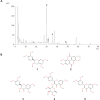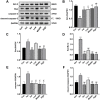Network Pharmacology-Based Combined with Experimental Validation Study to Explore the Underlying Mechanism of Agrimonia pilosa Ledeb. Extract in Treating Acute Myocardial Infarction
- PMID: 36132334
- PMCID: PMC9484776
- DOI: 10.2147/DDDT.S370473
Network Pharmacology-Based Combined with Experimental Validation Study to Explore the Underlying Mechanism of Agrimonia pilosa Ledeb. Extract in Treating Acute Myocardial Infarction
Abstract
Purpose: The network pharmacology approach and validation experiment were performed to investigate the potential mechanisms of Agrimonia pilosa Ledeb. (APL) extract against acute myocardial infarction (AMI).
Methods: The primary compounds of APL extract were identified by High-Performance Liquid Chromatography (HPLC) analysis. The intersecting targets of active compounds and AMI were determined via network pharmacology analysis. A mouse model of AMI was established by subcutaneous injection of isoproterenol (Iso). Mice were treated with APL extract by intragastric administration. We assessed the effects of APL extract on the electrocardiography (ECG), cardiac representative markers, representative indicators of oxidative stress, pathological changes, and phosphatidylinositol-3-kinase (PI3K)/protein kinase B (Akt) signaling pathway, as well as apoptosis-related indicators in the mice.
Results: Five candidate compounds were identified in APL extract. Enrichment analyses indicated that APL extract could exert myocardial protective effects via the PI3K/Akt pathway. ST segment elevation and increased heart rate were obviously reversed in APL extract groups compared to Iso group. We also detected significant decreases in lactate dehydrogenase (LDH), creatine kinase (CK), creatine kinase MB (CK-MB), malondialdehyde (MDA), and reactive oxygen species (ROS), as well as a significant increase in superoxide dismutase activities (SOD) after APL extract treatment. In addition, APL extract markedly decreased the number of apoptotic cardiomyocytes after AMI. In the APL extract groups of AMI mice, there were increased expression levels of p-PI3K, p-Akt, and B-cell lymphoma-2 (Bcl-2) protein, and there were decreases in Bcl-2-associated X (Bax), cysteinyl aspartate-specific proteases-3 (caspase-3), and cleaved-caspase-3 protein expression levels, as well as the Bax/Bcl-2 ratio.
Conclusion: APL extract had a protective effect against Iso-induced AMI. APL extract could ameliorate AMI through antioxidant and anti-apoptosis actions which may be associated with the activation of the PI3K/Akt signaling pathway.
Keywords: APL extract; PI3K/Akt; acute myocardial infarction; apoptosis; isoproterenol; oxidative stress.
© 2022 Zhang et al.
Conflict of interest statement
The authors declare no conflict of interest.
Figures











Similar articles
-
Cinnamaldehyde mitigates acute myocardial infarction by regulating ferroptosis through the PI3K-AKT signaling pathway.Int Immunopharmacol. 2025 Mar 26;150:114262. doi: 10.1016/j.intimp.2025.114262. Epub 2025 Feb 11. Int Immunopharmacol. 2025. PMID: 39938168
-
[Role and mechanism of Prussian blue nanoparticles in the apoptosis of mouse adipose-derived mesenchymal stem cells treated with hydrogen peroxide].Zhonghua Shao Shang Yu Chuang Mian Xiu Fu Za Zhi. 2025 May 20;41(5):481-490. doi: 10.3760/cma.j.cn501225-20240525-00197. Zhonghua Shao Shang Yu Chuang Mian Xiu Fu Za Zhi. 2025. PMID: 40419362 Free PMC article. Chinese.
-
Effects of dexmedetomidine postconditioning on myocardial ischemia and the role of the PI3K/Akt-dependent signaling pathway in reperfusion injury.Mol Med Rep. 2016 Jul;14(1):797-803. doi: 10.3892/mmr.2016.5345. Epub 2016 May 24. Mol Med Rep. 2016. PMID: 27221008 Free PMC article.
-
N-acetylserotonin protects PC12 cells from hydrogen peroxide induced damage through ROS mediated PI3K / AKT pathway.Cell Cycle. 2022 Nov;21(21):2268-2282. doi: 10.1080/15384101.2022.2092817. Epub 2022 Jun 26. Cell Cycle. 2022. PMID: 35758219 Free PMC article. Review.
-
Shexiang Baoxin Pill for Acute Myocardial Infarction: Clinical Evidence and Molecular Mechanism of Antioxidative Stress.Oxid Med Cell Longev. 2021 Nov 30;2021:7644648. doi: 10.1155/2021/7644648. eCollection 2021. Oxid Med Cell Longev. 2021. PMID: 34900089 Free PMC article. Review.
Cited by
-
Recent advances of traditional Chinese medicine against cardiovascular disease: overview and potential mechanisms.Front Endocrinol (Lausanne). 2024 Sep 30;15:1366285. doi: 10.3389/fendo.2024.1366285. eCollection 2024. Front Endocrinol (Lausanne). 2024. PMID: 39403576 Free PMC article. Review.
References
MeSH terms
Substances
LinkOut - more resources
Full Text Sources
Medical
Research Materials
Miscellaneous

